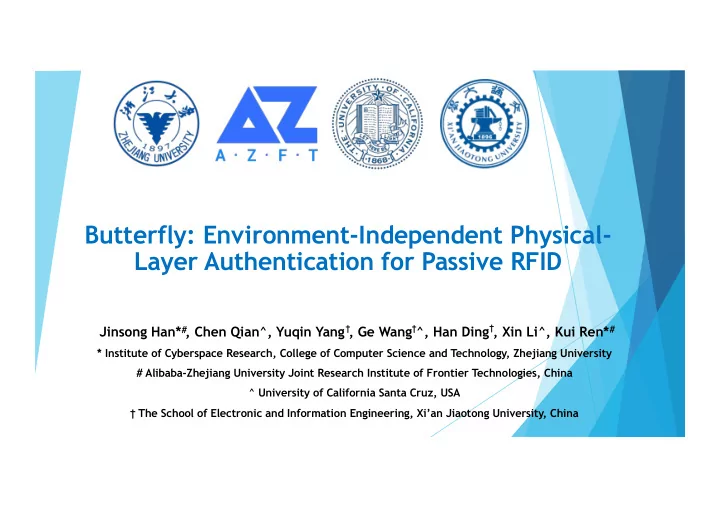

Butterfly: Environment-Independent Physical- Layer Authentication for Passive RFID † † † Jinsong Han* , Chen Qian^, Yuqin Yang , Ge Wang ^, Han Ding , Xin Li^, Kui Ren* # # * Institute of Cyberspace Research, College of Computer Science and Technology, Zhejiang University # Alibaba-Zhejiang University Joint Research Institute of Frontier Technologies, China ^ University of California Santa Cruz, USA † The School of Electronic and Information Engineering, Xi’an Jiaotong University, China
Tag Seal Entrance check Logistic and warehousing u u u RFID Authentication is a crucial task for many applications!
Prior authentication methods Tag counterfeiting? Don’t need Modification? Tag mobility? E1G2 Protocol E1G2 Protocol E1G2 Protocol Cryptology method Cryptology method Cryptology method Physical-layer Physical-layer Physical-layer Butterfly Butterfly Butterfly
Outline u Basic Idea u System Design u Experiments and Evaluation u Conclusion
Problem Statement Some practical factors introduce unpredictable errors in physical-layer signals: Position of the tag § § Surrounding environments § Different authentication devices
Basic Idea Our solution: employ two adjacent tags as an unit. Constant vector Feature ! = % " + ' " + ( ) + ( * + ( + Received signal: Gaussian Noise Environment Noise Device Noise # + ( * " " " # = % " # + ' " ! " # + ( ) # + ( + # Tag 1 , + ( * " " " , = % " , + ' " ! " , + ( ) , + ( + , Tag 2 ! " # - ! " , ≈ % " # − % " , + (' " # − ' " , )
Basic Idea Performance of noise elimination: § Our method can effectively eliminate the environment and device noises! Signals of different devices Signals in different environments Signals after elimination u u u
Outline u Basic Idea u System Design u Experiments and Evaluation u Conclusion
System Design Signal Preprocessing Cut EPC FFT Normalization Categorization Noise Elimination
System Design: Signal collection System deployment: USRP N210-based Monitor § ImpinJ R220 Reader § Two tags § System deployment u
System Design: Signal preprocessing Signal preprocessing: Cut EPC segment § Tag categorization § Noise elimination § QueryRep Query ACK RN16 EPC Signals received by the Monitor u
System Design: Signal preprocessing Signal preprocessing: Cut EPC segment § Tag categorization § Noise elimination § Tag categorization by K-Medoids u
System Design: Signal preprocessing Signal preprocessing: Cut EPC segment § Tag categorization § Noise elimination § ASP: Align Sample Point algorithm. Inconsistent signal caused by hardware u
System Design: Signal preprocessing Signal preprocessing: Cut EPC segment § Tag categorization § Noise elimination § Effectiveness of ASP u
System Design: Feature extraction Feature extraction: FFT § Low-pass filter § Normalization § After FFT After Low-pass Filter After normalization u u u
System Design: Feature matching Feature extraction: Overlapped rate R: § Pair 1 Pair 2 The features of different tag pairs u
Outline u Basic Idea u System Design u Experiments and Evaluation u Conclusion
Experiments and Evaluation Hardware: § Impinj R220 Reader § USRP N210 plus SBX daughterboard § 3 types of tags:Impinj E41-B, E41-C,Alien-9640 Deployment: The distance between the reader antenna and the § monitor antenna: D=0.5m ~1.5m The distance between two tags: 4cm § Metrics: False accept rate (FAR) § False reject rate (FRR) § Accuracy §
Experiments and Evaluation Case 1: The same authentication position. Case 2: Different authentication position in the same room. Case 3: Different authentication position in the different room. Comparison between Butterfly and prior solutions in two cases u
Experiments and Evaluation Changing the authentication devices:
Experiments and Evaluation Authenticate multiple tags: The ROC curve of multiple pairs u
Experiments and Evaluation Other factors: Tag rotation Rotations of tag pairs u
Outline u Basic Idea u System Design u Experiments and Evaluation u Conclusion
Conclusion § In this paper, we present an environment-independent physical layer authentication scheme for passive RFID tags, called Butterfly. § The main advantage of Butterfly is the resilience to environments, locations, and device changes, which are major problems in prior solutions. § We implement a prototype Butterfly and conduct extensive experiments for evaluation. The results show that Butterfly is very effective and accurate in authentication (up to 96.7%).
Thank you! Contact: hanjinsong@zju.edu.cn cqian12@ucsc.edu
Recommend
More recommend